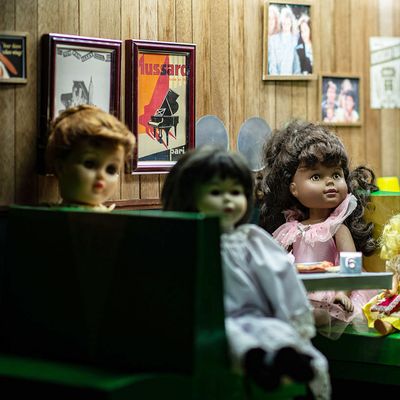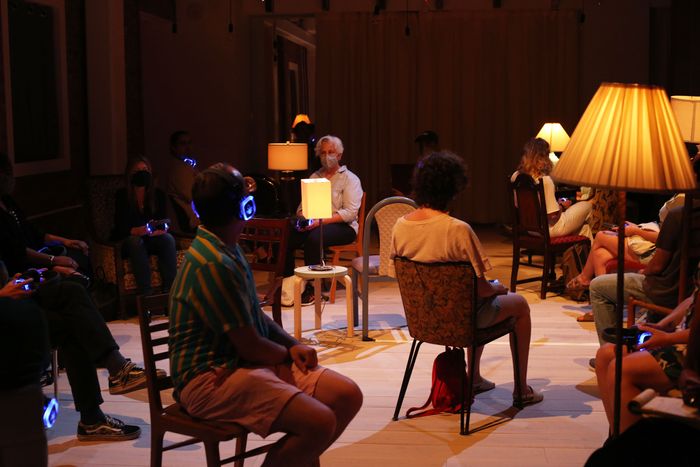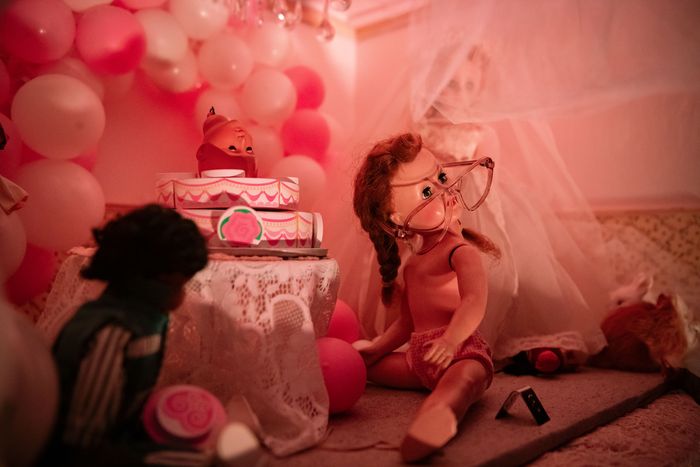
In theatrical discussions these days, artists debate digital performance. Will institutions keep producing online shows? Or is Zoom destined to be retired, filed alongside techniques like candlelight and dancing bears? But while conversation about digital rages, another pandemic method trundles quietly along: the installation. (Installations are environments in which an in-person audience encounters sound, sculpture, and other media, but never a living performer.) You donÔÇÖt get the same advocacy for installations that you do for digital work. No one claims theyÔÇÖll still be in the theatrical repertory after the recovery ÔÇö theyÔÇÖre such a profligate use of resources and space. Still, IÔÇÖll miss them a little. Installations create a sense of cosmic loneliness thatÔÇÖs rare in conventional drama, an art form which usually fills up every available cranny with bluster and presence.
The Mercury Store is in Brooklyn, a few blocks from the reeking Gowanus Canal and only steps from Third Avenue, where the air is heavy with asphalt fug. The newly converted warehouse is a clean pocket in that gray particulate haze; itÔÇÖs gleaming and elegant, with a blonde-wood lobby staircase descending in big amphitheater jumps to a polished floor. Whitney WhiteÔÇÖs Definition: An Installation Experience actually starts in this gallerylike foyer with a beautifully curated prologue, an exhibition of artworks and videos by (among others) Kenard Jackson and Cloteal Horne. Watching the videos before the start of WhiteÔÇÖs own show, we fill our minds with Black faces looking out of the video-screen frame, meeting our eyes, or seeming to connect with the unmoving paintings hanging around us.
Inside the main space, set designer Daniel Soule has made a gauze-curtained maze on a huge warehouse floor. There are no actors present. The audience wears wireless headphones that transmit WhiteÔÇÖs audio drama with music; at given moments, we move among ÔÇ£roomsÔÇØ created by the translucent drapes that partition the venue. We sit in a cozy corner filled with lamps and hear a woman, Sam, talking with her therapist. WeÔÇÖre ushered to a narrow oblong to hear a scene of Sam at her job. At her therapistÔÇÖs request, Sam goes to a museum, where she falls in love with MagritteÔÇÖs painting The Son of Man and attracts the gaze of the museum guard, the only other Black person she sees in the museum. In this contemplative plot, White and composer Dan RosatoÔÇÖs rock songs act as interludes. The numbers seem only lightly connected to the scenario; the connections stay elusive; we groove along in our quasi-private listening parties, as the mood remains muted, even a little stoned.
In her program note, White explains that sheÔÇÖs been working on the stage version of Definition for half a decade, converting it into this ÔÇ£snapshotsÔÇØ version only because of the shutdown. That explains why Definition seems to always be pointing elsewhere ÔÇö itÔÇÖs a trailer for the musical to come. Everything about the project shouts with its desire to not be an installation: The rock and roll wants to be jumping around in the room with us, not demurely playing on our headphones; WhiteÔÇÖs dramatic ideas about the shock of being seen (by a therapist, a lover, an inanimate painting) require a vivid energetic exchange. Definition is handsomely realized ÔÇö unsurprising, since itÔÇÖs produced by the Bushwick Starr ÔÇö but it feels like an experience under glass. Obviously weÔÇÖre in a period when everyone is scrambling just to make anything at all, working inside a shifting net of constraints. But the contrast between the strength of the preshow exhibition (all those video eyes, making contact) and the lassitude of the show itself highlights how much even our finest theater artists are struggling to choreograph an actorless space.
Theres more confidence on that front at the Tank, an OffOff theater complex on 36th Street. Structurally, the superb installation Samuel is similar to Definition: The audience (in pods of three) shifts from empty room to empty room, listening to the recorded show on headphones. But the Tank is scrappy. The clean, classy zones of Definition seem like waiting rooms in a 90s movie set in heaven. Samuel is, and I say this with love, as classy as a rat with a margherita pizza. Thanks to impressive installation artists Yi-Hsuan (Ant) Ma and Yizhu (Nina) Pan, there are creepy dioramas in each chamber made from dolls in an advanced state of disrepair. (You-Shin Chen is the visual designer.) Every chair I sat in looked like it had been stabbed. In the corner of one jerry-built enclosure, a towering pile covered with black fabric  shifted slightly.
Happily, Samuel feeds on that haunted-junk-shop vibe. Director Dara Malina and creative producer B.J. Evans are serving the eerie thriller by Alexis Roblan, a gifted writer whose audio play consists of disagreements among four sisters. These fights about the facts of their childhood veer past the hilarious and into the terrifying: Who played piano? Who was DadÔÇÖs favorite? Who remembers the serial murders? The youngest is also pretty sure they had a brother named Samuel, and his disappearance ÔÇö into a grave or a nightmare ÔÇö lurks at the back of every conversation. All the performances are deliciously lurid; the sound designers Ray Archie and Stephanie Singer make the (empty?) rooms prickle with supernatural dread. Be warned: The team has worked out how to manipulate the dreaminess incurred by audio drama. If you space out while listening, youÔÇÖll catch the eye of a baby doll whose head is on backwards. I jumped more than once.
Leaning into the ghostliness of a deserted theater seems to be the way these pieces work best. Because even if you donÔÇÖt intentionally make your installation a horror story (read: a story about grief), itÔÇÖs inevitably being performed on the set for one. For a little while, for instance, Soho Rep was presenting Stacey DerosierÔÇÖs installation Peep Show. It consisted of an enclosure with two doorways; inside were DerosierÔÇÖs paintings and sculptural objects, which I looked at, dutifully. But no one stopped you from wandering around outside the installation, through the dark and disused theater itself. If you wanted to, you could even go over and touch the folded-away chairs. The stage was so still! And I was so alone! It was chilling and lovely and mournful and alive. At the end of the day, installations are haunted houses. They take place in almost-abandoned places and throb with almost-life. Stand in the middle of one of these shows, it doesnÔÇÖt matter which, and youÔÇÖll feel an ectoplasmic shiver. ThereÔÇÖs so much thatÔÇÖs invisible in each of those rooms, all of it just on the other side of the veil.
Definition is at the Mercury Store through August 1.
Samuel is at the Tank through August 14, and is also available online.




